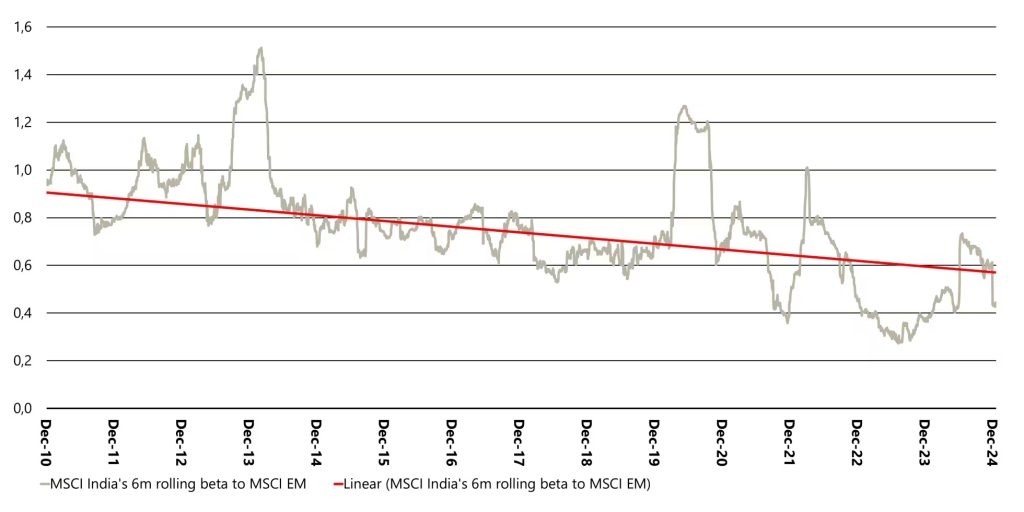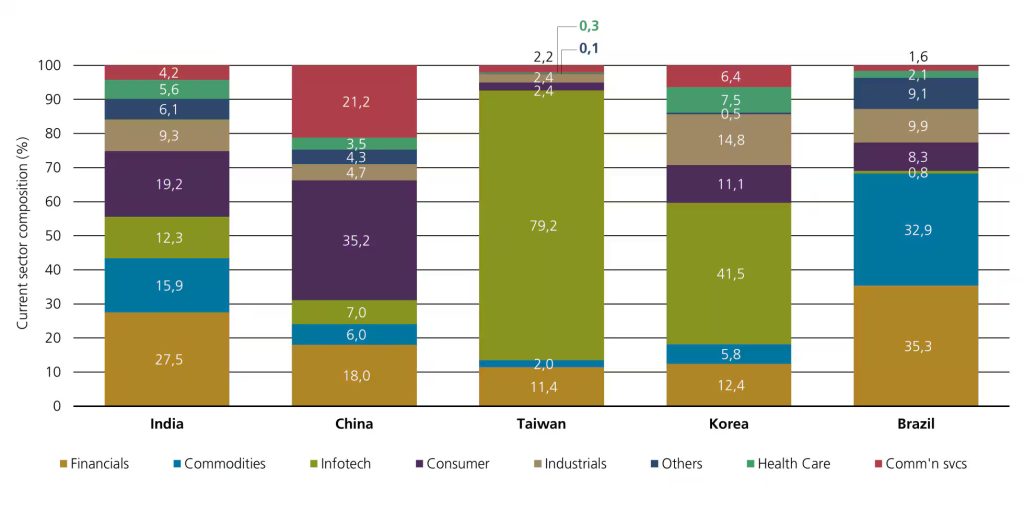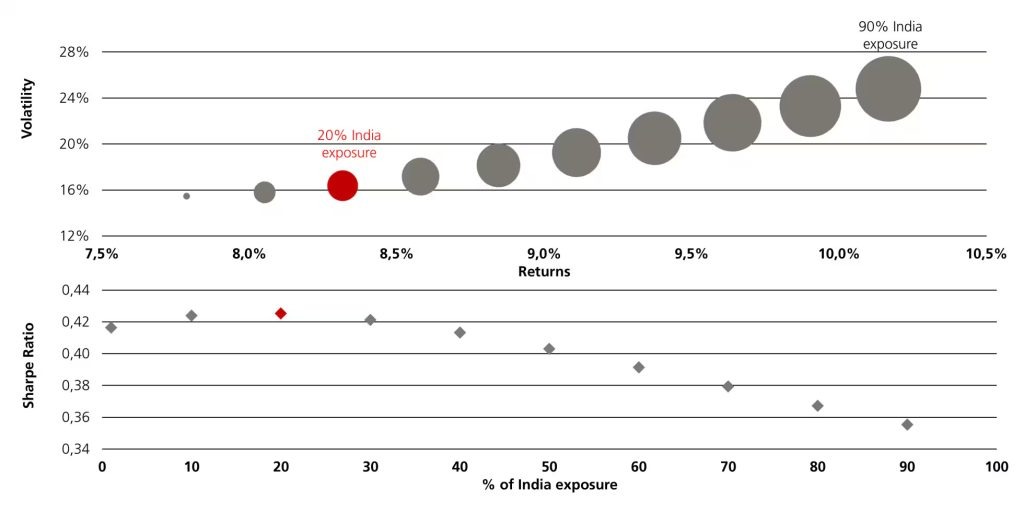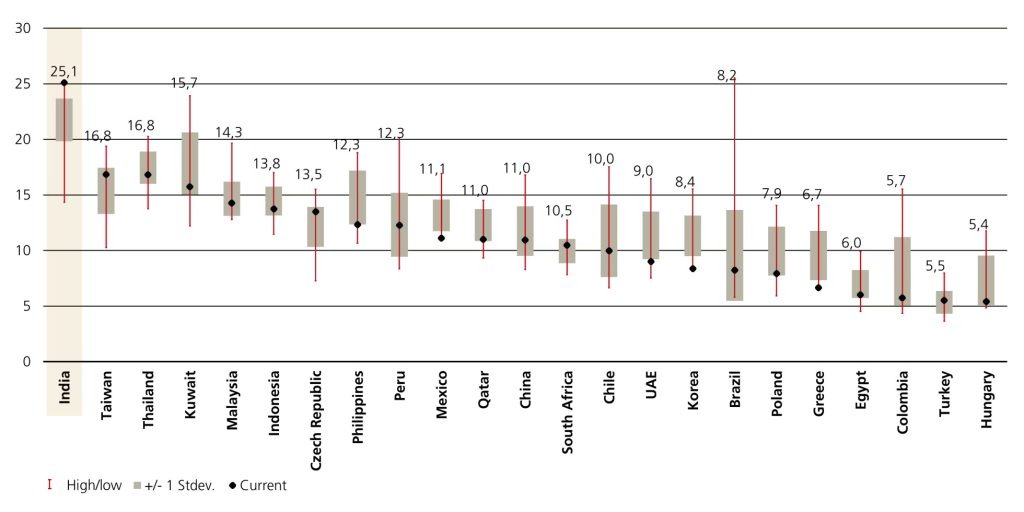Explore why India’s special characteristics have contributed to equity outperformance and how dedicated exposure could bring value to investors.
In the second installment of our India series, the EM and Asian Equities team discusses the potentially expansive alpha opportunities of investing in India as the country enters the small club of global economic superpowers.
Key takeaways
- Much of India’s stock market outperformance is driven by domestic factors and increasingly divergent from global events.
- Being less exposed to geopolitical tensions or a rising tariffs environment reinforces Indian equities’ relatively low correlation to global markets and their strategic role as a diversifier.
- Despite risks associated with emerging markets, India has made substantial progress in corporate governance and regulations.
- A standalone allocation to India has the potential to improve the risk-return profile and increase alpha opportunities of a global portfolio over time.
India’s extraordinary growth story is no secret: it is on track to become the world’s third largest economy by 2027, passing Japan and Germany and trailing only the US and China. The story goes beyond the immediate hype though, gathering strength from long-term themes such as global supply chain reconfiguration and a rising Indian middle class. Progressive structural reforms in many areas, such as improving export competitiveness, attracting foreign investments and creating a business-friendly environment through tax benefits, subsidies and other incentives, also provide the right setup for growth to continue in the long run.
At the same time, growth is domestically driven and presents a large set of attractive alpha opportunities. The impact of domestic factors on Indian markets outweigh that of external forces, and this growing independence from global events reinforces Indian equities’ relatively low correlation to global markets and their strategic role as a diversifier.
Financial services and credit growth
Several dominant and steadfast industries built the foundation of India’s fast-growing economy. As the country’s middle class and small businesses grow, the need for financial and banking services increases, particularly demand for consumer and business loans. Those loans to the private sector accounted for 50% of the country’s GDP in 2021, much lower than the 148% global average.1 Since 2022, credit growth had outpaced deposit growth though this gap is closing. Still, the debt burden is considered low in comparison to most developed economies and there is plenty of room for the financial and banking services sector to grow.
While financial deepening continues, policymakers have taken a cautious approach, learning from lessons of bad loans’ impact on the banking system and its liquidity in the last decade. A strong regulatory framework is now in place to ensure the financial system is stable and ready to support the country’s growth aspirations. There is also an emphasis on technology, building a digital infrastructure and payment system as part of the financial inclusion efforts.
Tech-tonic forces
Needless to say, technology plays a key role in India’s economy. Information technology consulting services has been one of the largest growth sectors for the country in the past two decades, currently accounting for 9.3% of the country’s GDP and over half of the global oursourcing market.2 The mammoth sector employs around 5.5 million people and is projected to generate more than USD 250 billion in revenue this year.3
While the sector gained initial scale because of India’s cost advantage, it has continued to thrive on a combination of a talented population educated on a STEM-focused curriculum and its early adoption of technology. The global adoption of 5G, artificial intelligence (AI) and the continued digitalization of India should fuel the sector’s ongoing growth.
Telecommunications connections
By 2040 the 5G technology is projected to contribute approximately USD 450 billion to the economy as India moves ahead to become the world’s second largest smartphone market.4 The demand for 5G should keep the telecommunications sector growing. Investments into building more telecom infrastructure for wider 5G adoption are strong, and nationwide broadband connections are a priority for the government. Previously, 4G broadband connections reached 99% of the country, linking up over 600,000 villages, and we believe the 5G network will follow a similar path.5 Incentives and regulations to ensure telecommunication services are affordable, as well as tariffs on related imports, should encourage domestic production.
Indian exceptionalism?
These core drivers are holding up a strong economy and rising equity markets. In fact, India is one of the world’s top performing equity markets for the past 5, 10, 15 and 20 years as measured by the leading domestic index BSE SENSEX 500 and as of September 30, 2024, in US dollars. The strong fundamentals are evidenced by GDP growth exceeding expectations, inflation remaining well within target, and corporate profitability approaching previous peaks. This economic robustness and an optimistic outlook have driven demand for Indian equities and enabled the market to outperform many emerging markets and global counterparts.
Exhibit 1: Will equity outperformance continue?
Annualized returns of major/MSCI Indices
As of end Sep 2024

Interestingly, the robust economic growth has driven underlying earnings growth higher, showing a strong positive link between GDP and earnings growth that is relatively uncommon, particularly in emerging markets, due to prevalence of domestic sectors (in the MSCI India index). This unique market characteristic puts a heavy emphasis on economic fundamentals. Should GDP growth continue on its current trajectory, there is potential for earnings – and by extension market performance – to keep growing at pace over the coming years, even though shorter-term periodic and/or cyclical corrections can be expected.
Much of the stock market outperformance was driven by domestic factors as more and more retail investors participate in the equity market. A large domestic investor base is building. A stable political environment with the reelection of the BJP government led by Prime Minister Modi translates into continuity of policy reforms on digitalization, financial inclusions, real estate, tax and infrastructure. In other words, what is keeping the market buoyant is increasingly divergent from global events and ultimately less exposed to geopolitical tensions or a rising tariffs environment.
Consider a standalone allocation
Becoming less sensitive to external factors makes the Indian equity market relatively insulated. The country’s low leverage profile, relatively low trade exposure to the US as well as low foreign equity ownership, echoed by foreign funds’ underweight to India in their portfolios, are some of the reasons why the equity market does not always move in tandem with global markets. At less than 20% as of Sep 2024, foreign ownership of Indian equities is the second lowest regionally after China A shares.6
While India represents about 20% of the MSCI EM Index, its correlations with other major regional and country indices are low. It also exhibits lower volatility compared to the MSCI EM Index, with beta falling over the past 15 years, which argues for a valuation premium to emerging markets.
Exhibit 2: India’s low correlations with global indices
Correlation (TR USD)
November 2004 to October 2024

Exhibit 3: Reducing volatility to EM commands a premium

This chart compares the six-month rolling beta of India and the overall emerging market from 2010 to 2024.
The depth and breath of the Indian equity market is also worth highlighting. India’s market is made up of not only mega caps like Reliance Industries, TATA Consultancy Services or Bharti Airtel but also a diverse group of mid-cap and small cap companies. The investible universe has been broadening over the years, and the current balanced mix of companies big and small and from different sectors presents the right conditions for sustained alpha delivery. Although diverse, the market is still somewhat inefficient. Identifying mispriced stocks especially undervalued ones offers the potential of excess returns.
Exhibit 4: MSCI EM markets – current sector composition

Source: Jefferies, FactSet, as of November 2024
This graph shows the sector composition of five MSCI EM markets: India, China, Taiwan, Korea and Brazil.
Exhibit 5: Percentage of stocks outperforming the index

This graph shows the number of stocks outperforming the benchmark for India, S&P500 and Asia ex-Japan from 2000 to 2023.
Given these characteristics, we argue that a standalone allocation to India has the potential to improve the risk-return profile and increase alpha opportunities of a global portfolio over time.
Based on our back test over the past 20 years, adding Indian equities market exposure (using MSCI India Net index performance) to a global developed markets (DM) portfolio (using the MSCI World Net index) would have boosted risk-adjusted returns of the global DM portfolio. The optimal level of exposure to Indian equities for the global DM portfolio would have been 20% based on our calculations.
Exhibit 6: Adding India to MSCI World improved risk-return profile
A back-test over past 20 years shows ~20% India allocation would have the best risk-return profile
Size of the bubble reflects % of INDIA exposure in MSCI World index

Calculation is based on 20Y ending Dec 2023 annualized returns of MSCI India Net and MSCI World Net (in USD), average 20Y U.S. T-Bills 30 Day (FTSE) as the risk-free rate
Source: Bloomberg, Global Composite System, as of November 2024
This graph shows the impact on returns and volatility as the percentage of India exposure in MSCI World Index increases.
Risks and challenges
Risks often come from the unknown, and investing in India is not without risks, especially in the near term.
The same high demand for Indian equities that drove the market higher also elevated their prices to above their long-term averages. The premium is at least partly the function of falling volatility and improving corporate earnings in recent years. That said, volatility did pick up in the near term. After peaking in late September, the BSE SENSEX corrected as oil prices jumped on supply interruption from the Iran-Israel conflict. India as an oil and coal importer remains sensitive to sharp changes in energy prices.
Exhibit 7: MSCI EM valuation by individual markets
12M forward price-to-earnings ratio (P/E), as of end September 2024
5Y historical P/E ending September 2024

Source: FactSet, UBS Asset Management, as of September 2024
This graph shows the five-year historical price-to-earnings ratio of India’s market compared to other major markets.
In addition, corporate earnings struggled in the September-end quarter. Weak consumption, muted government spending, excess rainfall and worsening cash flows led more than half of the companies to miss projections for the quarter, according to earnings estimates of BSE SENSEX 500 companies. This near-term moderation in earnings growth drove market volatility, with many foreign investors rushing to realize profits in recent months. And the news of the US indictment of Adani Group’s renewable energy arm over a multibillion dollar bribery scheme also triggered some near-term risk-off sentiment.
While there are risks associated with emerging markets, particularly around governance, transparency and regulatory scrutiny, India has made substantial progress recently with governance laws and regulations being upgraded and more Indian companies declaring a commitment to abide by corporate governance regulations. India is also viewed as relatively neutral on the geopolitical front and among the least exposed to trade policies from the incoming US administration. Notwithstanding the near-term ups and downs, India’s market volatility is still lower than emerging markets as a whole. Our outlook remains positive.
Taken together, we believe dedicated exposure to India could prove rewarding for global investors in the long run with the country on its path to become a global economic superpower.
2. Source: Finance Ministry, India.
3. Source: National Association of Software and Service Companies (NASSCOM), as of March 2024.
4. Source: Counterpoint Research, as of September 2024.
5. Source: Nokia MBiT Index, as of 2022.
6. Source: Bloomberg, National Securities Depository Limited (NSDL), as of September 2024.

